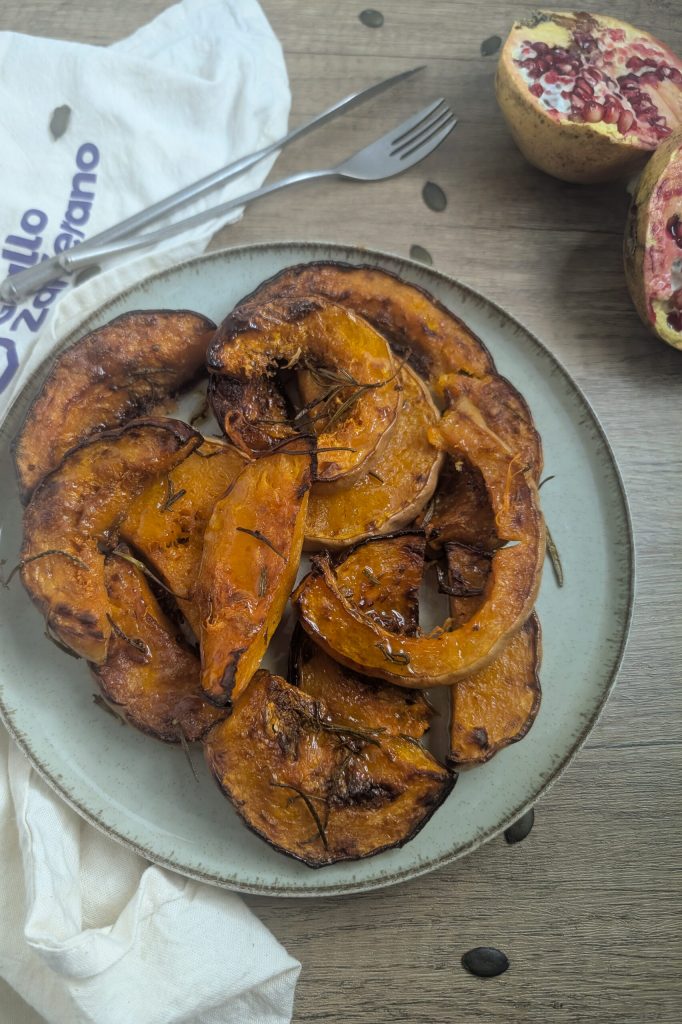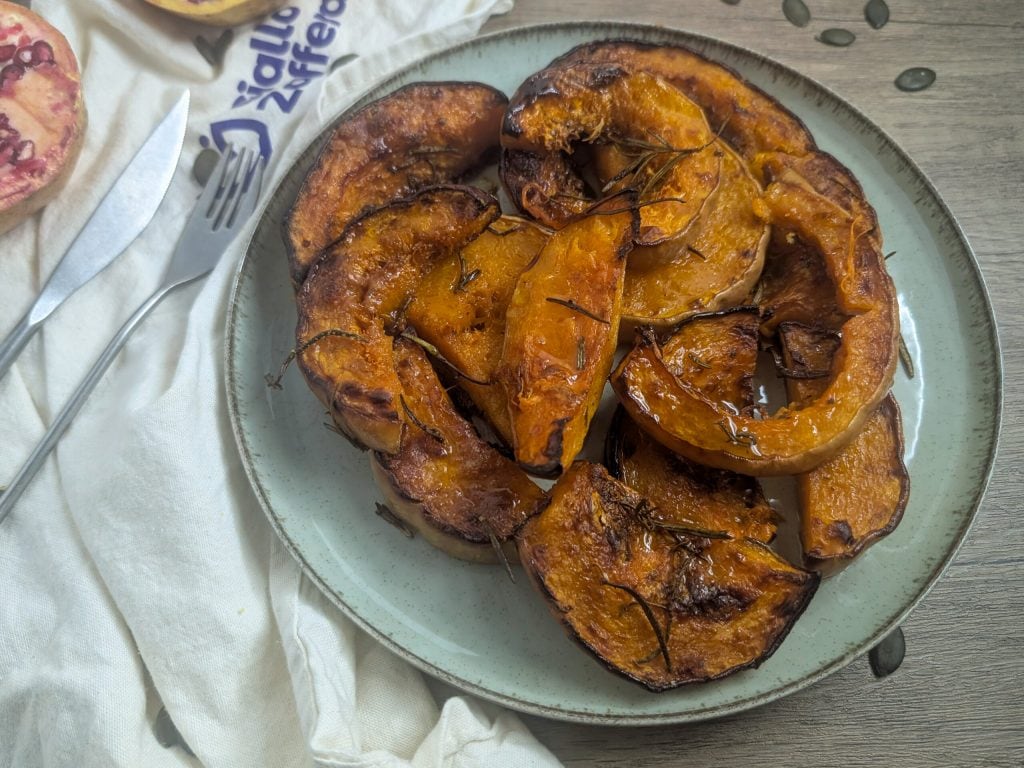Baked pumpkin, a timeless autumn classic, transforms into a symphony of flavors and textures in this recipe that will conquer your palate. Extra crispy on the outside, with a golden and inviting crust that encloses a soft and sweet heart, it will win over both big and small. I still remember when my son, then a little rascal of just five years, categorically refused to eat pumpkin. “It’s mushy!” he declared with a disgusted look, wrinkling his nose at every spoonful. But one day, almost by chance, I prepared baked pumpkin following this recipe. The magic happened as soon as I took the tray out of the oven: the intense and spicy aroma filled the kitchen, catching the attention of my little culinary critic. With a hesitant look, he tried a piece… and his eyes widened in surprise! “Dad, it’s delicious!” he exclaimed with enthusiasm, finishing the entire portion in no time. Since that day, baked pumpkin has become a must at our autumn dinners, a dish that unites us and gives us moments of sharing and joy. In fact, to be honest, now he demands it loudly every week! He’s six and a half years old and every time he sees a pumpkin at the supermarket, he starts hopping like a cricket, begging me to make “his” baked pumpkin. And woe to anyone who touches even a single piece! Don’t miss the video of this recipe, where Noah himself will show you how to make the best-baked pumpkin in the world (his words!). He will reveal all his secrets, from choosing the perfect pumpkin to tricks for impeccable cooking. Get ready to experience this sensory journey yourself by following my detailed recipe step by step. I’ll guide you in choosing the perfect pumpkin, revealing the tricks for cutting and seasoning it at its best, and accompany you through the cooking process until you achieve that irresistible crust that will make you fall in love. What are you waiting for? Turn on the oven and get ready to enjoy pumpkin like you’ve never tasted before!

- Difficulty: Very Easy
- Cost: Very Cheap
- Rest time: 10 Minutes
- Preparation time: 15 Minutes
- Portions: 4
- Cooking methods: Oven, Electric Oven
- Cuisine: Italian
- Seasonality: Autumn, Winter, All Seasons
- Energy 57.94 (Kcal)
- Carbohydrates 4.95 (g) of which sugars 3.38 (g)
- Proteins 2.13 (g)
- Fat 1.92 (g) of which saturated 0.53 (g)of which unsaturated 0.17 (g)
- Fibers 7.49 (g)
- Sodium 187.27 (mg)
Indicative values for a portion of 180 g processed in an automated way starting from the nutritional information available on the CREA* and FoodData Central** databases. It is not food and / or nutritional advice.
* CREATES Food and Nutrition Research Center: https://www.crea.gov.it/alimenti-e-nutrizione https://www.alimentinutrizione.it ** U.S. Department of Agriculture, Agricultural Research Service. FoodData Central, 2019. https://fdc.nal.usda.gov
Ingredients
- 1 kg butternut squash (Butternut)
- 4 tablespoons extra virgin olive oil
- 2 sprigs rosemary
- 2 cloves garlic
- to taste Grana Padano grated cheese
- to taste fine salt
- 1 pinch black pepper (Freshly ground)
Tools
- 4 Baking Trays
- 1 Mixing Bowl
Steps
To prepare baked pumpkin, start by thoroughly washing the butternut squash under cold running water and gently scrubbing the skin with a vegetable brush to remove any dirt residues. Dry the pumpkin with a clean dish towel and, using a sharp and sturdy knife, cut it in half lengthwise. Use a spoon to remove the seeds and inner filaments. Cut the pumpkin into slices about 0.4 inches thick: this thickness will allow the pumpkin to cook evenly, becoming soft inside and, thanks to the skin, crunchy on the outside. Transfer the pumpkin slices to a large bowl and season with extra virgin olive oil, slightly crushed garlic (not minced, to prevent burning in the oven), finely chopped fresh rosemary, fine salt, and freshly ground black pepper to taste. Mix gently with your hands, ensuring all slices are well-seasoned. If preferred, you can cut the pumpkin into cubes instead of slices, reducing the thickness to about 0.8 inches to ensure even cooking. For a more intense flavor, you can add other spices to the seasoning, such as sweet or hot paprika, cumin, or turmeric.

Once the pumpkin has been thoroughly washed, cut, and seasoned, it’s time to proceed with the cooking. Preheat the oven to 392°F in static mode. Meanwhile, line a baking tray with parchment paper. Arrange the pumpkin slices on the tray in a single layer, avoiding overlap to ensure even cooking. Sprinkle each slice with a generous handful of grated Grana Padano, which will form a golden and flavorful crust during baking. Place the tray in the hot oven and bake for about 40 minutes. After this time, the pumpkin will be soft and slightly caramelized, with a crispy skin and melted cheese. Remove the tray from the oven and let the pumpkin rest for a few minutes before serving.

And once out of the oven, let the pumpkin rest for a few minutes. Once it has cooled slightly, serve it hot as a side dish to meat, fish, or cheese dishes, or warm or cold as an appetizer or part of a buffet. If you prefer, you can also enjoy it as a vegetarian main course, accompanied by whole grains, legumes, and a fresh salad. Baked pumpkin is delicious on its own, but you can also get creative with herbs, sauces, nuts, or use it as an ingredient for soups, velvety purees, and other creative recipes. Enjoy your meal!

Here are some tips for baking pumpkin and storing it at its best:
Cooking Tips:
Choose the right pumpkin: For this recipe, butternut squash is ideal because it has firm and sweet flesh that lends itself well to baking. Ensure the pumpkin is ripe and its skin is free of dents or soft spots.
Cut the pumpkin evenly:
Try to cut the pumpkin slices to a similar thickness to ensure even cooking. If you prefer, you can cut it into cubes.
Don’t overdo the oil:
Season the pumpkin with the right amount of oil, avoiding excess to prevent it from becoming greasy.
Flavor to taste:
Besides rosemary and garlic, you can add other spices or herbs to personalize the pumpkin’s flavor. Try with paprika, sage, thyme, oregano, or a pinch of chili pepper.
Check the doneness:
Cooking time may vary according to the oven and the thickness of the pumpkin slices. To check for doneness, insert a fork into the flesh: if it goes in easily, the pumpkin is ready.
Storage:
Storage:
At room temperature:
If you intend to consume the baked pumpkin within a few hours of cooking, you can store it at room temperature covered with a sheet of aluminum foil.
In the refrigerator:
If you want to keep the baked pumpkin for 2-3 days, let it cool completely and place it in an airtight container in the refrigerator.
In the freezer:
You can also freeze the already baked pumpkin. Cut it into slices or cubes, let it cool completely, and store it in food-grade bags suitable for freezing.
Frozen pumpkin keeps for about 2-3 months.
I hope these tips are helpful!
Wine to pair with baked pumpkin with skin:
The choice of wine to pair with baked pumpkin depends on several factors, such as the variety of pumpkin, the seasoning used, and your personal tastes.
In general, pumpkin has a delicate and slightly sweet flavor that pairs well with aromatic white wines, soft with good acidity.
Here are some options: Gewürztraminer: This aromatic white wine, originating from South Tyrol, stands out for its floral and spicy notes, which pair perfectly with the sweetness of the pumpkin and the aromas of rosemary and garlic. Riesling: Another aromatic white wine with hints of yellow fruit, honey, and flowers that balances the sweetness of the pumpkin with its freshness and minerality. Sauvignon Blanc:
If you prefer a drier wine with pronounced acidity, Sauvignon Blanc is an excellent choice. Its herbal and citrus notes pair well with the pumpkin, especially if seasoned with aromatic herbs. Chardonnay: An unoaked Chardonnay, with tropical fruit and vanilla notes, can accompany baked pumpkin, especially if enriched with cheese or nuts. Classic method sparkling wine: For a more festive pairing, you can opt for a classic method sparkling wine, that with its effervescence and notes of yeast and nuts creates a pleasant contrast with the softness of the pumpkin.
If instead, you prefer a red wine, opt for a light one, with soft tannins and good acidity, such as a Pinot Noir or a Lagrein.
Ultimately, the best wine is the one you like most! Experiment and find the perfect pairing for your palate. 🍷
FAQ (Frequently Asked Questions)
What type of pumpkin is best for this recipe?
The recipe is designed for butternut squash, which has firm and sweet flesh, perfect for baking. However, you can also use other varieties of edible-skin pumpkins, such as Delica or Hokkaido. Just make sure the pumpkin is ripe and of good quality.
The recipe is designed for butternut squash, which has firm and sweet flesh, perfect for baking. However, you can also use other varieties of edible-skin pumpkins, such as Delica or Hokkaido. Just make sure the pumpkin is ripe and of good quality.

